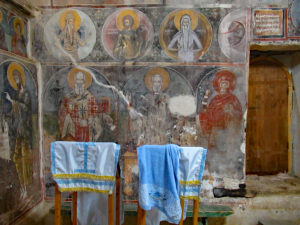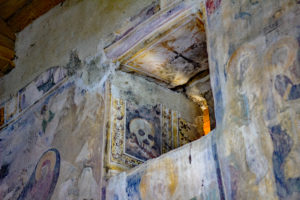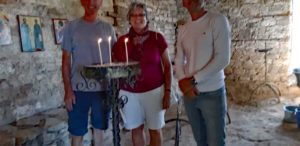As we were staying in Albania’s capital, Tirana, for five nights, we had time to spend a day out of the city with our driver, Edmond. Our destination was Elbasan, the country’s third largest city, and the Church of St Nicholas in nearby Shelcan.
The Tirana–Elbasan road is now a four-lane highway, part of the A3, which opened to traffic in June 2013. However, it was built without a full geological survey and some of the road collapsed and it was only finally completed in the summer of 2019. The construction involved blasting tunnels through the mountains and cut the journey of 43km to less than an hour.
On the outskirts of Elbasan, we saw a huge metal factory with tall chimney, known as the Steel of the People. It was built in 1974, during the communist regime, with technical and financial help from China. Although it employed 8,000 people at its peak, it’s now idle as it’s virtually impossible to bring it up the current day environmental standards.
Elbasan was an important commercial centre in the 17th century exporting leather, silverworks and fabrics throughout the Ottoman empire. However, its origins date back to the 2nd century BC when a trading post called Scampa grew up at the junction of the great Roman road, Via Egnatia,
On arrival, we parked at the hotel, Real Scampis. It had a fantastic location within the castle walls with archaeological remains visible below the café terrace. The grounds and gardens were beautiful, and we walked down an amphitheatre, across the lawn and exited up steps to the outside of the walls.
Our walk around town took us along the pedestrianised Boulevard Aqif Pasha with its 60m high clock tower, set into one of the bastions of the wall. The place had a ‘Sunday feel’ with a brass band playing and several fire engines parked up, with one of them having their ladder and platform extended up to the clock tower.
We continued to the theatre which was in the throes of a festival with boards in the foyer detailing all the numerous productions. Edmund got us a sneak preview of a rehearsal where a man was reciting in Albanian from behind a lectern.
We walked back along Via Egnatia and took photographs of the King’s Mosque, said to be one of the oldest in Albania.
Back in the car, we drove past lots of market stalls and people selling a huge range of items from blankets on the ground. We drove over the Shkumbini River and then began climbing, stopping for photographs of the steel factory from a different angle. We followed an unmade road, and turned off at a sign, Kisha Shen Kollit, to the 14th century Church of St Nicholas.
A small elderly chap arrived after a few minutes and opened up the church. This gave us chance to photograph the outside which looked rather plain, apart from a red cross in the walls. A carved metal bell hung from a pole in the grounds.
Inside, the frescoes which covered virtually all the walls, were in relatively good condition and they’d escaped from being whitewashed during Albania’s atheist period. They were painted by the famous Onufri, whose work we had seen in both the “National Museum of Medieval Art”:https://www.silvertraveladvisor.com/review/attraction/200725-review-national-museum-of-medieval-art in Korça, and also the “Onufri Museum”:https://www.silvertraveladvisor.com/review/attraction/201756-review-onufri-museum Onufri Museum in Berat. Bradt says they have been recently renovated, and we found what we think were the two mentioned in the guidebook: Lazarus rising from the grave, and Jesus entering Jerusalem on Palm Sunday. Interestingly there was a skull painted in one of the arched high windows. We asked if we could take photographs and the man shook his head and Edmond said yes without flash (a great example of the Albanian shake of the head, which means yes).
Unusually, we were invited to look behind the curtain into the altar area (usually verboten), to see the three headed Holy Trinity. An inscription showed that the frescoes, or at least some of them, were the work of Onufri in 1554. The old man also pointed out frescoes of Christ, Mary and John the Baptist.
The floor was simple stone with benches around the outside and what we assumed were regal garments hung up rather than someone’s drying washing. There was no iconostasis, but we couldn’t establish what had happened to it.
In the narthex was a large silver trophy and we gathered it was used as the baptismal font. It seemed a little out of place and we were told there was to be a christening later in the day. The elderly man gave us all a candle to light and offered to take a photo on Edmond’s mobile. We thought he was pretty adept, until we saw the photo later on. Whilst my head was visible, he’d chopped off the heads of the two chaps as he was so short.










